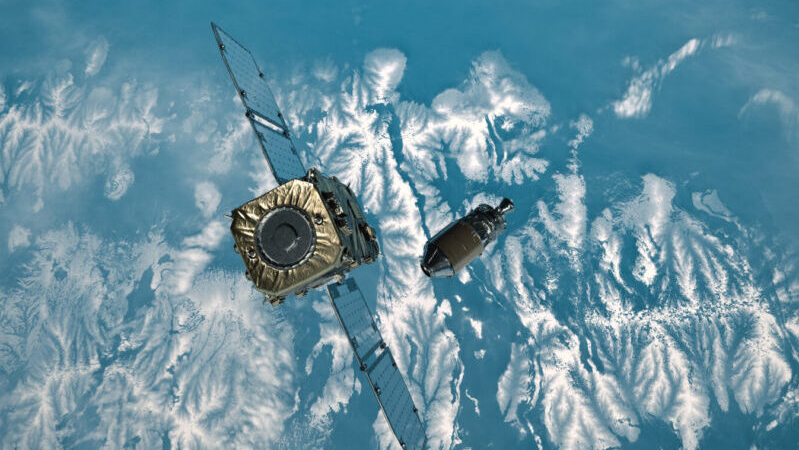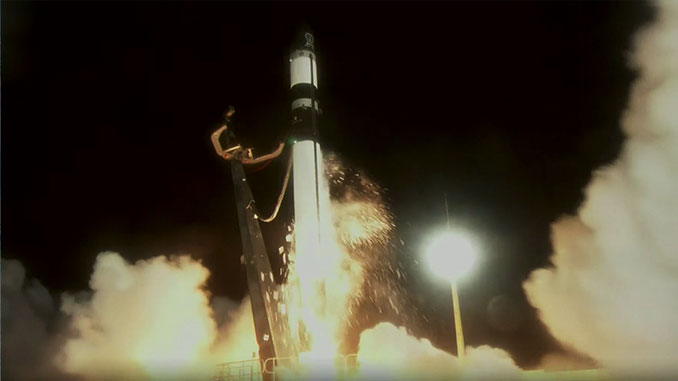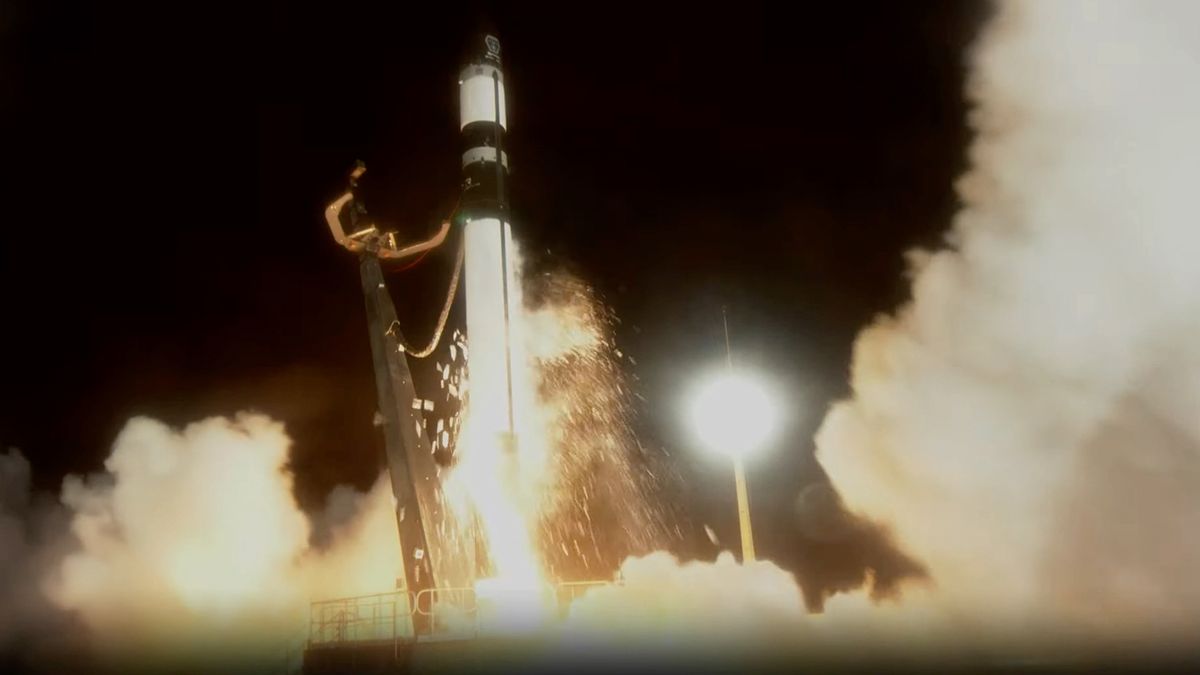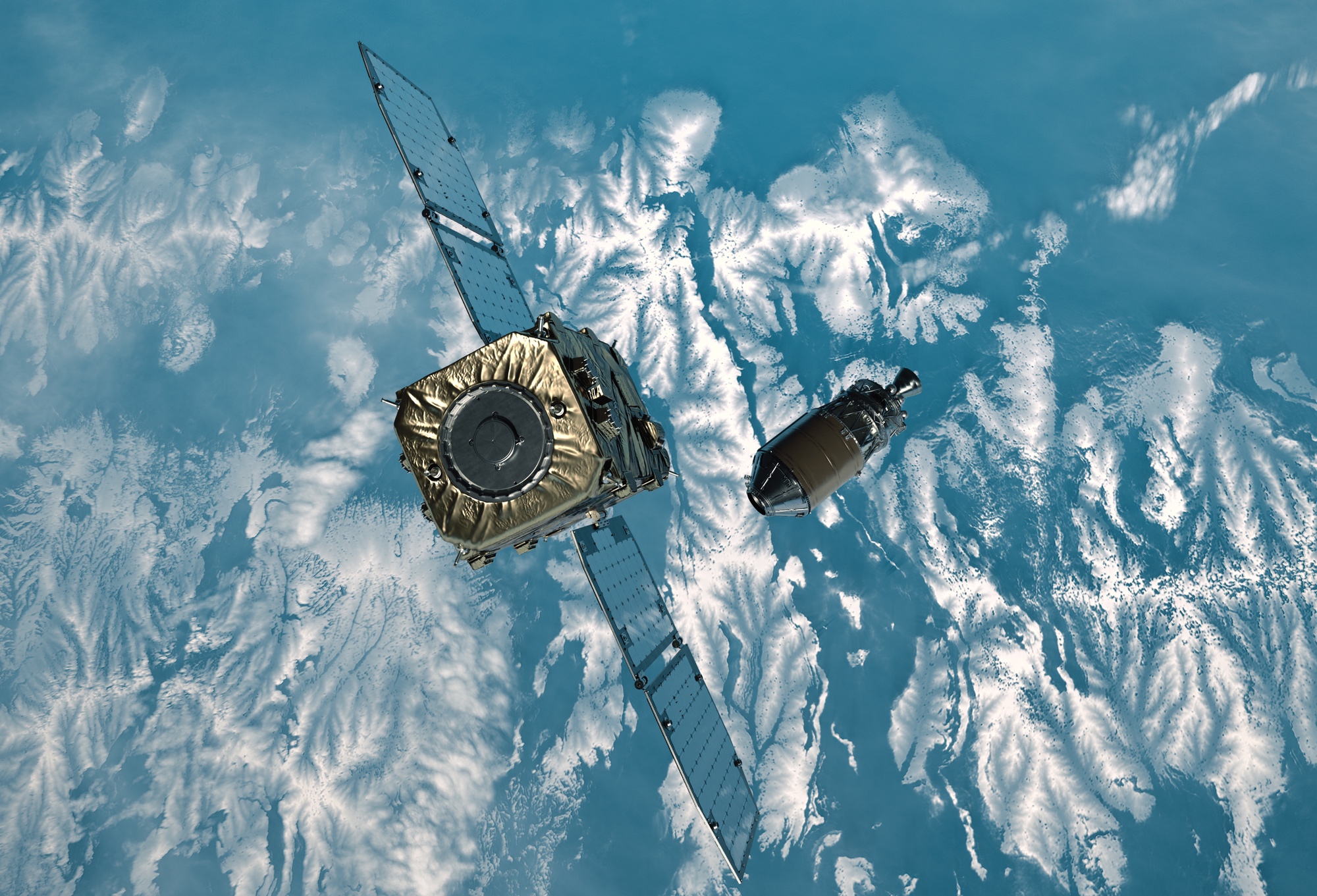Astroscale's ADRAS-J spacecraft has successfully entered orbit after a successful launch from New Zealand on Sunday. The satellite was sent to space atop an Electron rocket from Rocket Lab, which is the first time that this type of mission will be attempted in history.
Astroscale's ADRAS-J Successfully Enters Orbit After Launch from New Zealand on Electron Rockets
New Zealand, Mahia Peninsula New ZealandAstroscale's ADRAS-J spacecraft successfully entered orbit after a successful launch from New Zealand on Sunday.
The satellite was sent to space atop an Electron rocket from Rocket Lab, which is the first time that this type of mission will be attempted in history.









Confidence
80%
Doubts
- It is not clear if there were any issues with the launch or entry into orbit.
Sources
74%
Rocket Lab Electron rocket lifts off with space debris removal mission
Spaceflight Now Sunday, 18 February 2024 00:00Unique Points
- An Electron rocket launched from Rocket Lab's launch site on New Zealand's Mahia Peninsula carrying the ADRAS-J satellite for Astroscale
- The H-2A upper stage that ADRAS-J will approach is in a 622 x 557 km orbit, inclined at 98.2 degrees to the equator, has a mass of three tonnes, is 11 meters long and four meters in diameter
- ADRAS-J stands for Active Debris Removal by Astroscale-Japan
Accuracy
- The ADRAS-J satellite was deployed from Electron about 373 miles (600 kilometers) above Earth.
- ADRAS-J will rendezvous with an H-2A upper stage launched in 2009.
Deception (50%)
The article is deceptive in several ways. Firstly, the author claims that Rocket Lab's Electron rocket lifts off with a space debris removal mission when it only carries an ADRAS-J satellite for Astroscale to inspect and monitor a discarded H-2A rocket body in orbit. The article does not mention anything about removing space debris, which is the main purpose of the mission as stated by Rocket Lab CEO Peter Beck on social media.- The author claims that ADRAS-J was deployed 64 minutes into flight after two firings of the Electron's Curie kick stage to precisely place the spacecraft on course for its rendezvous in space. However, it does not mention anything about removing space debris.
- The author states that the ADRAS-J satellite will approach and monitor the spent upper-stage rocket of an H-2A rocket that launched in January 2009. However, it only mentions that it is part of JAXA's Commercial Removal of Debris Demonstration program and is designed to lay the ground work for a future mission to deobit the rocket stage, tentatively scheduled for 2026.
- The author claims that Rocket Lab's Electron rocket lifts off with a space debris removal mission when it only carries an ADRAS-J satellite for Astroscale to inspect and monitor a discarded H-2A rocket body in orbit. The article does not mention anything about removing space debris, which is the main purpose of the mission as stated by Rocket Lab CEO Peter Beck on social media.
Fallacies (85%)
The article contains several fallacies. The author uses an appeal to authority by stating that the mission is part of a Japanese space agency program without providing any evidence or context for this claim. Additionally, the author makes an inflammatory statement about Rocket Lab CEO Peter Beck's social media post, which could be seen as biased and not based on objective reporting. The article also contains several dichotomous depictions of the ADRAS-J satellite's mission, such as describing it as bothBias (100%)
None Found At Time Of Publication
Site Conflicts Of Interest (50%)
There are multiple examples of conflicts of interest in this article. The author is affiliated with Rocket Lab and Astroscale, which are both involved in the space debris removal mission being reported on.- Astroscale's ADRAS-J satellite or ADRAS J was deployed to precisely place the spacecraft on course for its rendezvous in space.
- Rocket Lab is hosting this launch, which could potentially benefit from a successful mission.
- Rocket Lab's Electron rocket lifts off with a space debris removal mission.
- The article mentions that Nobu Okada founded Astroscale in 2013 with the goal of offering on-orbit servicing and space debris removal services.
- The article mentions that Rocket Lab is headquartered in Japan and has subsidiaries in the United Kingdom, France, and Israel.
Author Conflicts Of Interest (0%)
None Found At Time Of Publication
74%
Rocket Lab launches ADRAS-J space junk inspection satellite for Astroscale (video)
Space.com Mike Wall Sunday, 18 February 2024 05:01Unique Points
- Rocket Lab launched an ambitious space-junk inspection satellite for the Japanese company Astroscale on Sunday morning (February 18).
- The ADRAS-J mission will be the world's first attempt to safely approach and characterize an existing piece of large debris through rendezvous and proximity operations.
- ADRAS-J stands for Active Debris Removal by Astroscale-Japan, true to its name, the satellite will try to make progress in humanity's fight against space junk.
- The mission is the first phase of an orbital debris removal program and during this phase ADRAS-J is designed to test technologies and operations for approaching and monitoring debris objects.
Accuracy
- ADRAS-J is equipped with visual and infrared cameras and LiDAR sensors to assess the rocket body's condition and gauge its tumbling.
Deception (50%)
The article is deceptive in several ways. Firstly, the author claims that ADRAS-J will be the world's first attempt to safely approach and characterize an existing piece of large debris through rendezvous and proximity operations. However, this statement is false as there have been previous missions that have done so before such as NASA's Dawn mission in 2015 which successfully inspected two asteroids Vesta and Ceres. Secondly, the author claims that ADRAS-J will try to make progress in humanity's fight against space junk, a problem that continues to grow as we launch more and more satellites into orbit. However, this statement is also false as there are already existing companies such as Astroscale who have been working on removing space debris for years. Lastly, the author claims that ADRAS-J will deliver data that will assist in removing space junk to ensure sustainable use of space for future generations. This statement is partially true but it does not mention anything about how this data will be used or what specific actions Astroscale plans to take with it.- The author claims that ADRAS-J will be the world's first attempt to safely approach and characterize an existing piece of large debris through rendezvous and proximity operations. However, this statement is false as there have been previous missions that have done so before such as NASA's Dawn mission in 2015 which successfully inspected two asteroids Vesta and Ceres.
- The author claims that ADRAS-J will try to make progress in humanity's fight against space junk, a problem that continues to grow as we launch more and more satellites into orbit. However, this statement is also false as there are already existing companies such as Astroscale who have been working on removing space debris for years.
Fallacies (85%)
The article contains an appeal to authority fallacy by stating that Astroscale CEO and founder Nobu Okada said in a video statement. The author also uses inflammatory rhetoric when describing the problem of space junk as 'a growing menace'. Additionally, there is no evidence provided to support these claims.Bias (100%)
None Found At Time Of Publication
Site Conflicts Of Interest (50%)
Mike Wall has a financial tie with Astroscale as he is an investor in the company. He also has personal relationships with Nobu Okada and Rocket Lab as they are all involved in space junk inspection.Author Conflicts Of Interest (50%)
Mike Wall has a conflict of interest on the topic of space junk inspection as he is an author for Space.com and Astroscale is a company that provides services related to space debris removal.
74%
Electron launches Astroscale inspection satellite
Space News Site: https://spacenews.com/lunar-time-standard/ Jeff Foust Sunday, 18 February 2024 16:06Unique Points
- Astroscale launched an inspection satellite called ADRAS-J to rendezvous with and inspect a spent upper stage in low Earth orbit.
- ADRAS-J was developed by Astroscale as the first phase of JAXA's Commercial Removal of Debris Demonstration (CRD2) program, with the goal to approach an H-2A rocket upper stage launched in 2009 and inspect it.
- ADRAS-J is expected to last three to six months and will demonstrate rendezvous and proximity operations capabilities including safely approaching and operating around the upper stage while collecting information about it for a future mission to grapple and deorbit it.
Accuracy
- The Electron launch was the second this year for Rocket Lab after the Jan. 31 launch of four satellites for space situational awareness company NorthStar Earth and Space.
- Astroscale said it made contact with ADRAS-J after deployment, signaling the start of its mission to survey and characterize a real piece of debris through its innovative rendezvous and proximity operations capabilities.
Deception (50%)
The article is deceptive in several ways. Firstly, the author claims that Astroscale's ADRAS-J spacecraft will rendezvous with and inspect a spent upper stage in low Earth orbit as a precursor to removing it. However, this statement is misleading because there are no plans to remove the upper stage after inspection. Secondly, the article states that ADRAS-J was developed by Astroscale as the first phase of JAXA's Commercial Removal of Debris Demonstration (CRD2) program. However, this statement is also misleading because CRD2 is a joint project between Japan and other countries including Australia, Canada, France, Germany and Italy. Thirdly, the article claims that ADRAS-J will approach an H-2A upper stage in low Earth orbit as a precursor to removing it. However, this statement is also misleading because there are no plans to remove the upper stage after inspection.- The article states that CRD2 is a joint project between Japan and other countries including Australia, Canada, France, Germany and Italy. However this statement is also misleading because the program was originally called JAXA's Commercial Removal of Debris Demonstration (CRD) but it has since been expanded to include international partners.
- The author claims that ADRAS-J will approach an H-2A upper stage in low Earth orbit as a precursor to removing it. However, this statement is also misleading because there are no plans to remove the upper stage after inspection.
- The author's claim that Astroscale's ADRAS-J spacecraft will rendezvous with and inspect a spent upper stage in low Earth orbit as a precursor to removing it is deceptive.
Fallacies (85%)
The article contains several logical fallacies. The author uses an appeal to authority by citing the expertise of Astroscale and Rocket Lab in their respective fields. This is not a fallacy itself, but it can be seen as an attempt to establish credibility without providing evidence for it. Additionally, the author uses inflammatory rhetoric when describing ADRAS-J's mission as 'the first mission that will approach and rendezvous with an actual piece of space debris'. This statement is not necessarily false, but it can be seen as sensationalist and exaggerated.- The author uses an appeal to authority by citing the expertise of Astroscale and Rocket Lab in their respective fields. For example: 'Astroscale was developed by Astroscale as the first phase of JAXA's Commercial Removal of Debris Demonstration, or CRD2, program.'
- The author uses inflammatory rhetoric when describing ADRAS-J's mission as 'the first mission that will approach and rendezvous with an actual piece of space debris'. For example: 'This is to my knowledge the first mission that will approach and rendezvous with an actual piece of space debris.'
Bias (100%)
None Found At Time Of Publication
Site Conflicts Of Interest (50%)
Jeff Foust has a financial interest in Astroscale as he is an investor in the company. He also has a professional affiliation with Rocket Lab as they are both involved in space debris removal.Author Conflicts Of Interest (50%)
Jeff Foust has a conflict of interest on the topics of Astroscale and Rocket Lab as he is an author for SpaceNews.com which covers these companies.
78%
A satellite designed to inspect space junk just made it to orbit
Engadget Cheyenne MacDonald Monday, 19 February 2024 03:19Unique Points
- Astroscale's ADRAS-J spacecraft is now in orbit after a successful launch from New Zealand on Sunday.
- The satellite was sent to space atop an Electron rocket from Rocket Lab. Its mission, which was selected by Japan's space agency (JAXA) for Phase I of the Commercial Removal of Debris Demonstration program, will see ADRAS-J rendezvous with an old Japanese rocket upper stage that's been in orbit since 2009.
- ADRAS-J is now in orbit, ready to start its mission of rendezvousing with an aging piece of space debris and observing it closely to determine whether it can be deorbited in future.
- The accumulation of waste in Earth's orbit from decades of spaceflight is an issue of growing concern, and space agencies around the world are increasingly working to address it, in many cases tapping private companies to develop potential solutions. One of the most effective ways to deal with space junk could be to deorbit it, or move it to a lower altitude so it can burn up in Earth's atmosphere.
- ADRAS-J will be the first to target a piece of existing large debris and attempt to safely approach and characterize it, relying on ground-based data to hone in on its position. Over the next few months, it will make its way to the target and eventually try to get close enough to take images and assess its condition.
- ADRAS-J is officially on duty and ready for rendezvous with some space debris!
- Let the new era of space sustainability begin!
Accuracy
- The mission of ADRAS-J is to rendezvous with an aging piece of space debris and observe it closely to determine whether it can be deorbited in future.
- ADRAS-J will fly around the stage, inspecting it with cameras and after deployment from Electron, Astroscale's full mission will take between three and six months to complete.
Deception (100%)
None Found At Time Of Publication
Fallacies (75%)
The article contains an appeal to authority fallacy by stating that the mission of ADRAS-J was selected for Phase I of the Commercial Removal of Debris Demonstration program. The author does not provide any evidence or reasoning behind this claim.Bias (75%)
The article is biased towards the success of Astroscale's ADRAS-J spacecraft and its mission to inspect space junk. The author uses phrases such as 'Astroscale's ADRAS-J spacecraft', 'ADRAS-J rendezvous with an old Japanese rocket upper stage that's been in orbit since 2009', and 'Proud to be part of this innovative mission studying ways to deorbit space debris'. These phrases suggest a positive bias towards Astroscale and its role in the mission. Additionally, the author uses language such as 'an issue of growing concern' when referring to space junk, which could be seen as an attempt to elicit sympathy for the problem rather than presenting it objectively.- 🛰️👋
- ADRAS-J rendezvous with an old Japanese rocket upper stage that's been in orbit since 2009
- Astroscale's ADRAS-J spacecraft
Site Conflicts Of Interest (50%)
Cheyenne MacDonald has a conflict of interest on the topic of space junk cleanup as she is affiliated with Astroscale and Rocket Lab. She also mentions JAXA in her article which could indicate that she may have ties to Japan's space agency.Author Conflicts Of Interest (50%)
Cheyenne MacDonald has a conflict of interest on the topics of Astroscale and JAXA as she is affiliated with both companies.
67%
On Closer Inspection | Electron
Everyday Astronaut Florian Kordina, Thursday, 15 February 2024 16:35Unique Points
- On Closer Inspection is Rocket Lab's 44th launch overall and its second launch this year, as well as its 11th launch from Launch Complex-1B, Māhia Peninsula, New Zealand.
- Astroscale Japan Inc.’s mission patch for its ADRAS-J mission.
- ADRAS-J is a technology demonstrator and is part of JAXA's Phase 1 of Commercial Removal of Debris (CRD2) project.
- The payload mass will be approximately 564.6 km x ~629.4 km Sun-synchronous orbit (SSO) at 98.2° inclination.
- ADRAS-J will rendezvous with an H-2A upper stage launched in 2009.
Accuracy
- ADRAS-J stands for Active Debris Removal by AstroScale Japan, true to its name, the satellite will try to make progress in humanity's fight against space junk.
Deception (100%)
None Found At Time Of Publication
Fallacies (85%)
The article contains several fallacies. The author claims that the mission is a dedicated launch for Astroscale Japan Inc., but they do not provide any evidence to support this claim. Additionally, the author does not mention who will be paying for the launch or if it has been funded by government or private entities.- The article states that On Closer Inspection is a dedicated launch for Astroscale Japan Inc., but no evidence is provided to support this claim.
Bias (85%)
The article is biased towards Rocket Lab and their mission. The author uses language that portrays the company in a positive light, such as calling Electron a dedicated launch for Astroscale Japan Inc. to carry one satellite into an approximately 564.6 km x 629.4 km Sun synchronous orbit (SSO) at 98.2° inclination and describing the mission as 'a technology demonstrator' and a part of JAXA’s Phase 1 of Commercial Removal of Debris (CRD2) project.- The article describes Electron as a dedicated launch for Astroscale Japan Inc. to carry one satellite into an approximately 564.6 km x 629.4 km Sun synchronous orbit (SSO) at 98.2° inclination.
- The mission is described as 'a technology demonstrator' and a part of JAXA’s Phase 1 of Commercial Removal of Debris (CRD2) project.
Site Conflicts Of Interest (0%)
Florian Kordina and Mariia Kiseleva have a conflict of interest on the topic of Rocket Lab as they are both affiliated with Astroscale Japan Inc., which is involved in commercial removal of debris (CRD2) for Rocket Lab. They also have a financial tie to H-2A rocket, which was launched by JAXA and used in GOSAT's launch into space.- Florian Kordina has been the CEO of Astroscale Japan Inc., which is involved in commercial removal of debris (CRD2) for Rocket Lab. He also has a financial tie to H-2A rocket, which was launched by JAXA and used in GOSAT's launch into space.
- Mariia Kiseleva is the CEO of Astroscale Japan Inc., which is involved in commercial removal of debris (CRD2) for Rocket Lab. She also has a financial tie to H-2A rocket, which was launched by JAXA and used in GOSAT's launch into space.
Author Conflicts Of Interest (0%)
Florian Kordina and Mariia Kiseleva have a conflict of interest on the topics of Rocket Lab, Electron, Astroscale Japan Inc., ADRAS-J, Sun-synchronous orbit (SSO), H-2A rocket, space debris environment and commercial removal of debris (CRD2) as they are affiliated with these entities.- Florian Kordina is the CEO of Rocket Lab. He has a financial stake in the company and may have a bias towards its success.